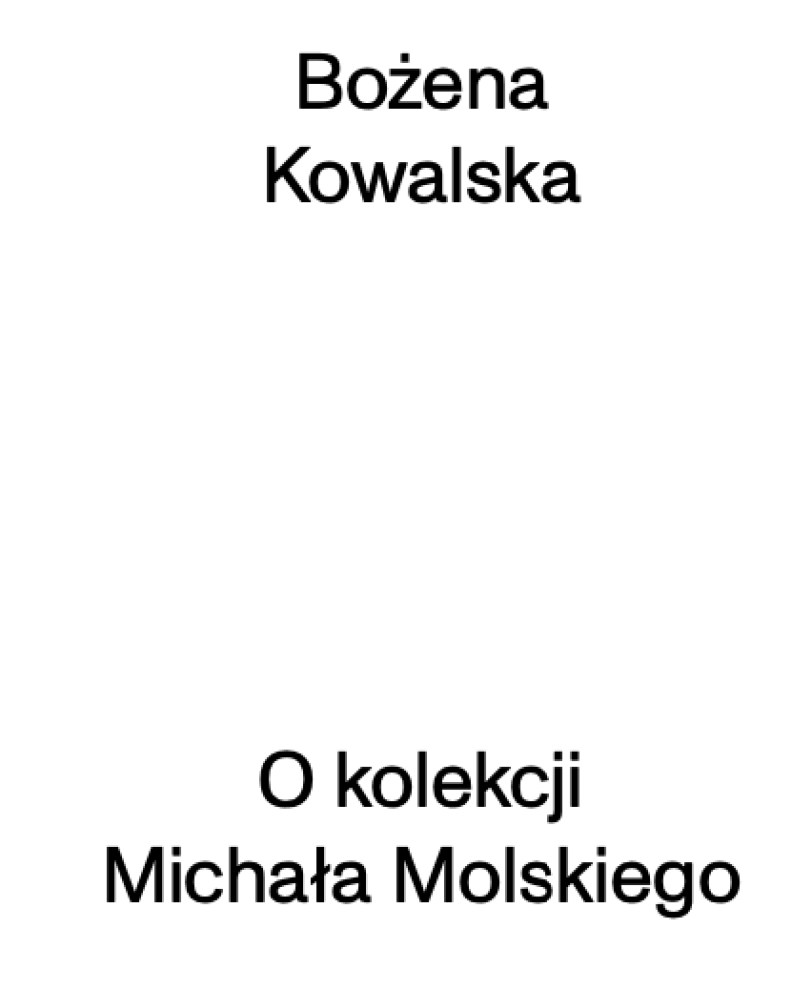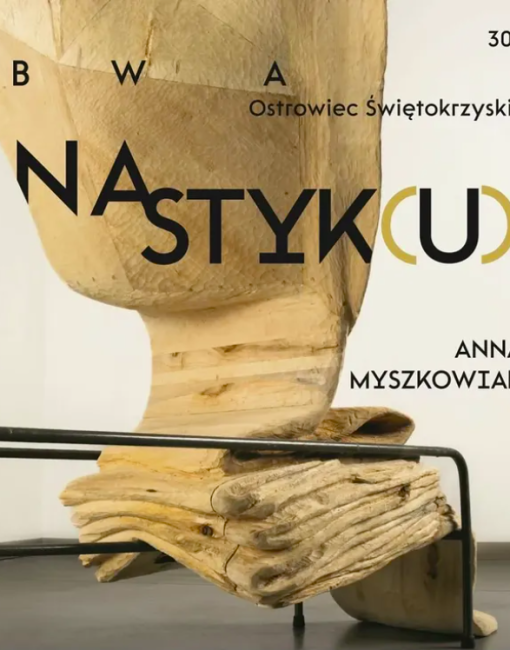
Bożena Kowalska "About Michał Molski's collection"
On June 22, 2023, Professor Bożena Kowalska - an outstanding theorist, critic and art historian - passed away. The catalog of the "Contemporary Art Collection" published in 2022 includes a text - one of the last by Ms. Bożena - dedicated to our collection.
Bożena Kowalska "About the collection of Michał Molski"
Collecting art objects has its own, rather distant past. The main difference between that 17th and 18th century and the present day is that the collectors of that time were the royal court and the magnates, and they collected almost exclusively objects of the past, with disregard for contemporary art. The collections of that time, which remain their priceless social merit, mostly became the foundations of future museums. On the other hand, in the 20th century and today, collecting focuses almost exclusively on contemporary art and develops with great momentum, while still fulfilling a socially important role. This time of popularizing contemporary art and establishing its value in the public perception.
In Poland after World War II, when the country was reborn from the rubble and economically returned to relative equilibrium, many private collections were created, multiple and at the same time worthy of attention and recognition, to recall for example Andrzej Starmach, Grażyna Kulczyk, Wojciech Fibak, the Bieńkowski brothers, Grzegorz Król and Jacek Łozowski, or Jerzy Stelmach collector and author of a book on collecting titled "Persistent predilection".
They are constantly being joined by new collectors of contemporary art, although not this latest, post-modernist art, also known as postmodern art, using digital media, whose property is often ephemeral and which has often lost the value of a material and unique object.
Michał Molski, whose collection today already includes about a hundred items, joined the significant group of collectors currently active in Poland relatively recently, around 2010. Prof. Andrzej Ryszkiewicz - an insightful researcher of the phenomenon that occupies us here wrote as follows: "When (...) people have satisfied their most basic needs in life, when they have reached a certain level of wealth (...) then the temptation to collect appeared. And more strictly in some it reveals itself, comes to the surface, claims its rights, and in others it arises born from someone else's example or from one's own idea." In Molski's case, it was not someone else's example, but an innate inner need that revealed itself through his own choices according to his personal taste and his own idea. The decisive event was an accidental encounter with the serigraphy of Wojciech Fangor, fascination with it and, consequently, its purchase. From that moment: realizing the need to coexist with art and collecting it, the young collector began to gain more knowledge, read about it with growing interest, spend a lot of time at exhibitions and enter more and more deeply into the circle of artists. In his choices he was not and still is not guided by any relative conjuncture. The decisive factor in them is the feeling of closeness or even bond with the chosen object, so the need to continue to interact with it.
As a result, Molski's collection is quite diverse, both in terms of the character and means of artistic expression of individual artists, as well as their generational affiliation reaching from Henryk Stażewski - the aged protagonist of the pre-war constructivist avant-garde, to Antoni Starowieyski of the still very young generation - creator of meaningfully puzzling compositions with unusual poetics of color contrast. This diversity of the collection ranges from the expressive abstractions close to Alfred Lenica's gesture painting to the moody representationalism of Jaroslaw Modzolewski and the limited abstractionism of Tadeusz Dominik, the peculiar figurativeness of Jan Dobkowski to the perfect asceticism of Mieczyslaw Janikowski. Despite this diversity, Molski's collection is somehow consistent. This is determined by the logic of the direction of its creator's preferences. As Jerzy Stelmach writes: "Collecting is an attempt to realize the dream of owning one's own world (...) a search for an interpretive cipher. Without interpretation, an in-depth understanding of art, there can be no collecting. "In Molski's selection of works for the collection, one sees two tendencies that give it common, binding characteristics. First and foremost, it is the need for a calming order, an order often expressed through rhythmization and consequently, in terms of form, descending to geo-metric structures.The second feature is much more difficult to describe, for it concerns the meditative sphere, what Stelmach called the interpretive cipher.
The works collected by Molski are, for the most part, works by recognized, outstanding artists, in whom this meditative factor plays an extremely important role. For Molski, this factor is also so important that it prompts him to carefully observe the selected object and finally purchase it so that in solitary concentration he can contemplate it by reading the author's message contained in it, as well as his loves, anxieties and questions, usually left unanswered. This is a world of intellect, in-depth analysis of art, creation of individual rules for the construction of compositions and even a separate, purely individual formula of beauty. This is the case with the still physiological-erotic mostly works of Jan Dobkowski, Izabela Gustowska addressing the issue of human differences and similarities, and ultimately the characteristics and limits of the human condition, or Leon Tarasiewicz seeking the simplest and most abbreviated signs for the visual rendering of natural phenomena.
The main, largest group in Molski's collection is made up of artists of the geometric trend. They are mature and excellent artists, extremely diverse in their ways of thinking and, as a result, their messages. Leading among them remains Henryk Stażewski, who achieved perfect harmony by simple means, and who, like Strzemiński, considered, studied and analyzed the problems of art itself: compositional arrangements and subtle variations in color. He wrote in 1953 on loose sheets of paper that he distributed to friends: "Abstract art is the most unified, holistic and organic vision of shapes and colors. It aims at the highest sensitivity of our eye, achieving absolute hearing of color sensitivity and mathematical precision in sensing form and proportion."
In contrast to Stażewski's mathematized approach, the geometry of Janikowski, who began his work with landscapes, may also be precise, but neither in a "mathematical" nor contemporary way is there anything of a technicized and emotionally cooled world. Its geometric forms, as in the Indian art of Tantra, were signs to convey universal concepts and symbols of philosophical and religious content. One reads in them references to the infinity of the world, to the secrets of the unknown sacrum.
For Jerzy Kalucki, who is close to mathematics and operates in painting with geometry, the main problem of thought and imagination is space. Real, surrounding and subject to shaping, but also the one reaching to the imagination of infinity, evoked by intuition, not cooled by calculations, saturated with emotion. As the artist writes: "it can be said that space is deeply rooted in our perception of the all-pervading element, which, however, can in our consciousness undergo processes of abstraction from real situations becoming an intentional space. As a result, it lends itself to various treatments and interpretations, which are autonomous creations of our mind. It is important for art that the emotionality of the first sensation can be transferred by signs into the field of conceived space, equipped, moreover, with all the possibilities of intellectual play."
Similarly, although in a completely different way, space was the main object of Jan Berdyszak's fascination and the primary means of action in his work. It focused attention on itself as a puzzling object of ontology, but also of science, and therefore an intriguing problem for the intellect. It played a role in the artist's works as a carrier of messages, an area of contemplation and a sphere of reflection. In a 1970 notebook he wrote about it: "The emptiness of space has an advantage over everything, since it cannot be destroyed as life, objects and forms can be destroyed."
Both Jan Berdyszak's more over-intellectualized works and Kalucki's more romantic paintings introduce an atmosphere of meditation, admittedly provoking eternal, fundamental questions about infinity and finitude, but in a purely secular way.
Finally, Tadeusz Gustaw Wiktor and Tamara Berdowska deserve special attention among the outstanding artists of the geometry trend in Molski's collection. Neither of them has chosen or treats the language of geometry as an accepted program. Besides, this would not be possible in the realization of their art. Each of them paints paintings with unlimited freedom, as their inner imperative dictates, which can neither be gotten rid of nor silenced. Victor uses geometry because it helps him organize his composition, and sometimes, to enhance the power of expression, it is used to introduce relief elements into the painting. It also happens that the outline of a gothic church facade appears in the great concert for light and colors of his captivating canvases. Because Tadeusz Wiktor's art is deeply religious. It is mystical art. The author himself writes in his reflections: "My cognitive-meditative goal is to express the Absolute through painting. This orientation of the creative process, although it originates from the terrain of art, places it above art."
The same creative process of transcendence, only that it is fully secular, resulting from the creative act itself, occurs with Tamara Berdowska. This is an unusual phenomenon, but it also produces the results of paintings that are unusual, brilliant in color and formally revealing. Geometry is needed by the artist mainly to bring out the unique sensation of intense and even violent movement in the inherently static paintings.
Halfway between geometric abstraction and objectivity are the characteristic original paintings of Jan Tarasin. All his life his art has been swinging towards or away from motifs from reality. "He doesn't want," the artist explained, "for what I do to have direct references to some finished creation of nature. I deal with objects on many floors of de-objectification. "These de-realized objects-not-objects always run in horizontal lines-mysterious signs conveying the artist's ontological reflection on the basic law governing the world, on the sidelines of the artist's observations that nothing repeats itself in nature and that it always remains a mystery. "In nature, the most important thing is the coexistence of determination and chance, order and chaos. Nature is free from artificial divisions, nothing is chaos alone, nor is anything order alone," the artist states. Although Tarasin's work is based on observation of nature, it is extremely different from Winiarski's work, which is inspired by mathematics, they both came to the same conclusion about the principle that determines the fate of the world.
Molski's collection is diverse and rich. It contains many outstanding paintings, with the collector seemingly aware that most of the great artists - are not only artists, but also thinkers. Tarasin claimed that painting is not a goal, but a path. The goal is to answer the question of what the world is.
Footnotes:
1. A. Ryszkiewicz, Kolekcjonowanie i miłośnicy, PWN, Warszawa, 1981, s. 9–10
2. J. Stelmach, Uporczywe upodobanie. Zapiski kolekcjonera, 2012, s. 17–18
3. J. Kałucki, Zwierzenia o przestrzeni geometrii, Zeszyty Artystyczne PWSSP w Poznaniu, Poznań, 1985, s. 51
4. T.G. Wiktor, Teksty artystów, Galeria QQ, Kraków, 1994, s. 51
5. Rozmowa z prof. Tarasinem / w katalogu wystawy: Jan Tarasin, Galeria Starmach, Kraków, 1999, s. 6
6.Ibidem, s. 7





